In The News
- Read on this page: Looking For Answers 5 Years After The Gulf Oil Spill
- Read on this page: Professor Contributes to Research on Oil Spills
- Read on this page: Mount Allison researcher part of a $7.25 M grant to study effects of Gulf of Mexico oil spill
- Read on this page: Opportunities: Aggregation and Degradation of Dispersants and Oil by Microbial Exopolymers (ADDOMEx)
- Read on this page: ODU's Hatcher on Gulf Oil Spill Research Team
- Read on this page: Consortium led by Texas A&M University at Galveston awarded $7.25 million to support research on the effects of the Deepwater Horizon oil spill
Looking For Answers 5 Years After The Gulf Oil Spill
April 13, 2015
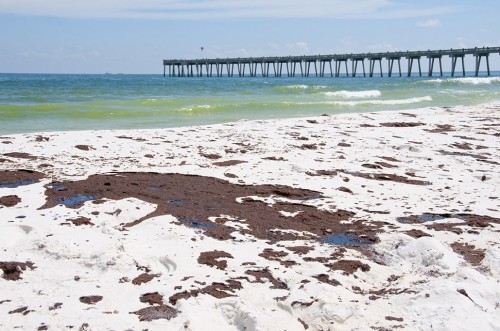
The 2010 Gulf oil spill was the worst in U.S. history.
(Photo: Shutterstock)
As the fifth anniversary of the Deepwater Horizon explosion in the Gulf of Mexico approaches, numerous Texas A&M University scientists are involved in some of the most advanced research in the world on various projects related to the worst oil spill in the history of the petroleum industry – one that they say may take many years to understand its long-range effects.
They say their research could also help communities cope more effectively in the event of a similar incident in the future.
On April 20, 2010, the huge rig exploded in the Gulf, killing 11 people and releasing almost 5 million barrels – at least 210 million gallons – of oil for 87 days before being capped on July 15.
Antonietta Quigg, professor and associate vice president for research and graduate studies at Texas A&M-Galveston, received a $7.2 million grant from the Gulf of Mexico Research Initiative to study the impacts of the oil on the Gulf ecosystem and public health. The grant is part of a $500 million fund established by BP to support research about the spill.
“One of our main goals is to study how hydrocarbons trigger production of substances that may protect organisms from the oil or contribute to the degradation of the oil, or both,” Quigg explains.
“This can help us understand the fate of the oil, such as how it degrades, disperses or its sedimentation once an oil spill occurs. The information may help us establish better predictive models for future spills, and also improved risk assessment and management plans.”
As for long-term effects to marine life, Quigg says that extensive research is being done in this area, and “we are just now getting a better picture of what this may be. We do know that marine life from the smallest creatures to fish, turtles and whales may carry the consequences of the spill.”
Also working with Quigg on the project are Texas A&M colleagues Peter Santschi (professor of marine science on the Galveston campus), and Tony Knap and Terry Wade (director and deputy director, Geochemical and Environmental Research Group, or GERG, in College Station).
Piers Chapman, professor of oceanography, heads a multi-university group that has been busy since the spill – they have made seven research cruises near the spill area and are about to head out again to study a natural gas seep. Their focus is studying oil in the water column and how and where it moves, and collecting samples for fellow oceanographer Shari Yvon-Lewis, who is examining the carbon system in the Gulf and how it has changed since the spill.
On the other ship is Scott Socolofsky of Texas A&M’s civil engineering faculty, who with the aid of a remotely operated vehicle, is looking at the bubble plumes produced by the seep and how these develop and disperse.
“We have developed models that we believe can follow an oil particle from its initial release until it ends up on the beach,” Chapman points out. “This includes such changes as dissolution, evaporation and dispersion within the water column as well as slick movement on the surface.
“To do this, we had to carry out a number of lab tests and field programs and these have given us a much better idea of how fast the Gulf of Mexico material mixes around.”
Working with Chapman is oceanographer Steve DiMarco, who has been studying the physical transport of water and material in the region of the spill. He and his group recently completed a unique experiment using dye as a “tracer” to determine how fast dissolved and particulate material move around in the Gulf.
“The data, obtained over a year, together with data on currents from moorings deployed simultaneously and left in place for two years, are providing important information in our modeling work,” DiMarco says. Texas A&M oceanographers Rob Hetland and Ping Chang are also involved with the modeling program.
“What we do know for sure was confirmed to us – that the Gulf is a very energetic and turbulent place,” DiMarco adds. “It has a unique geography to it because it is a large semi-enclosed basin, and the motion of the water is enhanced.”
Former Texas A&M oceanographer John Kessler did several landmark studies on methane gas in the Gulf in the weeks following the explosion. Calling the results “extremely surprising,” he and fellow researchers found that methane gas concentrations in the Gulf of Mexico had returned to near normal levels several months after the Deepwater Horizon explosion, and that Mother Nature quickly saw to the removal of more than 200,000 metric tons of dissolved methane through the action of bacterial blooms that completely consumed the immense gas plumes.
At that time, the team reported finding methane gas in amounts nearly 100,000 times above normal levels. But about 120 days after the initial spill, they could find only normal concentrations of methane and clear evidence of complete methane respiration. Kessler is now at the University of Rochester.
Another project involves DEEPEND, which stands for Deep-Pelagic Nekton Dynamics of the Gulf of Mexico and focuses on deep oil and gas wells and their effects on marine life. It will key on the pelagic (open ocean) realm, from the surface to depths of over a mile, by far the largest ecosystem component of the Gulf.
Since the spill, more than 1,000 dead dolphins have washed ashore from Texas to Florida, about four times the normal rate.
In addition, the number of sea turtle nests has declined since the spill, 12 percent of the brown pelicans and 32 percent of the laughing gulls may have died as a result of the spill, and 2010-2011 had the lowest numbers of juvenile red snapper since 1994. DEEPEND researchers want to know conclusively if the spill contributed to the large kills and declines.
Almost 2,000 deep-sea exploration wells have been drilled by the oil and gas industry in the past few decades, and this activity is increasing both in scope and depth, the researchers say. “The Deepwater Horizon oil spill has demonstrated a worst-case scenario oil disaster at great depths, while also highlighting the paucity of baseline data for deep-ocean ecosystems in the Gulf of Mexico and elsewhere,” says Jay Rooker, a marine biologist at Texas A&M-Galveston and one of the leaders of the project.
“Without such data, and information on the drivers of natural variability in these systems, impacts from these activities are difficult or impossible to assess.” The group hopes to get valuable answers to some critical questions about oil and marine life. Also involved are David Wells and Ron Eytan of Texas A&M-Galveston.
For more about research on the oil spill, go to http://gulfresearchinitiative.org/.
###
Contact: Antonietta Quigg at (409) 740-4990 or quigga@tamug.edu, Piers Chapman at (979) 845-9399 or piers.chapman@tamu.edu, Steve DiMarco at (979) 862-4168 orsdimarco@tamu.edu or Jay Rooker at (409) 740-4744 or rookerj@tamug.edu or Bob Wright at (409) 740-4840 or (713) 586-9870 or wrightb@tamug.edu or Keith Randall, News & Information Services, at (979) 845-4644 or keith-randall@tamu.edu
Professor Contributes to Research on Oil Spills
March 11, 2015
http://www.ucmerced.edu/news/2015/professor-contributes-research-oil-spills
Researching oceanic oil spills can be difficult when you work at a landlocked university like UC Merced.
But thanks to a large consortium of researchers from around the country, that’s exactly what Professor Wei-Chun Chin Opens a new window is doing in the hopes of understanding the deeper, long-term effects of spills to better deal with them.
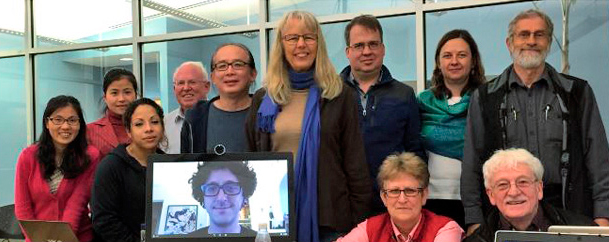
The ADDOMEX team, including Professor Wei-Chun Chin (center left), is researching oil spills.
His work drew him to the Aggregation and Degradation of Dispersants and Oil by Microbial Exopolymers (ADDOMEX) consortium, one of 12 selected by the Gulf of Mexico Research Initiative (GoMRI) to study the impacts of oil, dispersed oil and dispersants on the Gulf of Mexico ecosystem and public health.
After the Deepwater Horizon oil spill in 2010, which killed 11 people and is considered the largest marine oil spill in history, crews tried many methods to “clean up” the Gulf of Mexico. They vacuumed up the oil, sprayed thousands of gallons of detergent to disperse the oil and even burned it off.
Researchers found a proliferation of microbes that seemed to consume some of the oil, as well. Dinoflagella, bacteria and phytoplankton helped the Gulf appear cleaner, but even though oil is no longer visible, that doesn’t mean it’s gone, Chin said.
“We need to understand it, because this was a whole new experience for us,” Chin said. “I don’t want people — or oil companies — to take this lightly. The oil is gone from the surface, but we do not know the long-term consequences.”
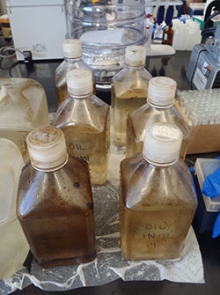
Small samples like these are enough
for Professor Wei-Chun Chin to apply
his microfluidics tests and gather
data about oceanic oil spills.
Professor Antonietta Quigg of Texas A&M University at Galveston, the lead investigator for the group Chin is working with, said spills are an unfortunate reality of oil companies pushing deeper into new drilling frontiers.
ADDOMEX studies the formation of “marine snow,” Mother Nature’s effort to clean up spills.
“Microbes that enjoy hydrocarbons dine on the all-you-can-eat carbon buffet during a spill,” Quigg said, “and in essence, return the oil back to the bottom of the ocean. Our research is focused on understanding what those microbes are doing and how, which will help us understand the fate and transport of the oil in the oceans.”
The microfluids Chin uses in his lab allow for small-scale experiments on samples of ocean water the other researchers send to him. He looks at the effects of microbes on spills, the effects of dispersants on the microbes and microbial interactions.
GoMRI began in 2010, after the oil spill, and is funded by British Petroleum (BP) — the company responsible for the Deepwater Horizon event — for 10 years.
Each consortium is funded through 2017 and must include researchers from at least four universities. ADDOMEX is led by Texas A&M University at Galveston, which has a marine station at the Gulf where researchers can sample water for their work. Other members include Old Dominion University, UC Santa Barbara and the University of Southern California.
“Oil spills can happen anywhere. They can come from ships like the Exxon Valdez, or from drilling operations like Deepwater Horizon,” Chin said. “And it’s true that the oceans can clean themselves, but it takes a long time, and we do not want to abuse them.”
Mount Allison researcher part of a $7.25 M grant to study effects of Gulf of Mexico oil spill
February 25, 2015
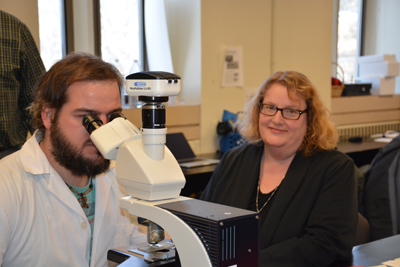
SACKVILLE, NB — Mount Allison University geography and environment professor Dr. Zoe Finkel is collaborating with researchers in a multi-university consortium that received $7.25 million to study the impact of the Deep Water Horizon oil spill on both the Gulf of Mexico ecosystem and public health. The spill released approximately 4.1 million barrels of oil into the gulf and another 1.84 million gallons of the chemical Corexit was added to disperse the oil.
Finkel, Canada Research Chair in Marine Environmental Ecology and co-ordinator of the Environmental Science program at Mount Allison, is an expert on the physiology of phytoplankton, the microscopic photosynthetic organisms found in the surface layers of the oceans. She will be investigating how oil and the dispersant Corexit has effected the microbial communities of bacteria and phytoplankton in the Gulf of Mexico and how these communities influence the fate, distribution, and potential effects of oil in the marine ecosystem.
“I’m thrilled to be able to join this consortium to study this important environmental problem,“ says Finkel. “The consortium brings together world-class researchers and will make it possible to tackle much bigger problems than we could work on individually.”
The consortium, called ADDOMEx for the aggregation and degradation of dispersant and oil by microbial exopolymers, is led by Dr. Antonietta Quigg, professor of Marine Biology and associate Vice-President for Research and Graduate Studies at Texas A&M’s Galveston campus. It includes eight investigators from six US research institutions and one Canadian institution, Mount Allison.
According to Finkel, oil released into the environment during an oil spill changes the community of microbial organisms living in the ocean, and they in turn affect the oil by dispersing, consuming, aggregating, and sinking it out of the water column. It is a complex relationship that is poorly understood.
“Chemicals added to disperse oil spills, such as Corexit, in turn affect the make-up of the microbes, their growth and their ability to break down and aggregate the oil. Phytoplankton and bacteria release sticky carbon compounds, exopolymers, that can influence the fate of oil in marine ecosystems,” says Finkel. “The research of ADDOMEx will clarify how microbial exopolymers are formed and how the fate of oil is influenced by the interactions between microbial communities, the concentration of oil and dispersant, and by environmental conditions.”
“The ultimate goal of our project is to improve society’s ability to understand, respond to, and lessen the effects of oil pollution on marine and coastal ecosystems, with an emphasis on conditions found in the Gulf of Mexico. What we learn will be applied to restore and improve the long-term environmental health of the Gulf of Mexico.”
As well as Mount Allison and Texas A&M, other collaborating institutions include the University of California, Merced, the University of Southern California, the University of California, Santa Barbara, and Old Dominion University. The consortium is part of a larger group of 12 consortia funded by a $140 million grant for 2015-2017 from the Gulf of Mexico Research Initiative, which was established by British Petroleum to fund independent research in response to the Deep Water Horizon oil spill.
Photo caption: Mount Allison University geography and environment professor and Canada Research Chair in Marine Environmental Ecology Dr. Zoe Finkel, right, is part of multi-university consortium established to study the impact of the Deep Water Horizon oil spill on both the Gulf of Mexico ecosystem and public health. Mount Allison is the only Canadian institution collaborating on the $7.25m research project.
Opportunities: Aggregation and Degradation of Dispersants and Oil by Microbial Exopolymers (ADDOMEx)
February 24, 2015

The explosion of the Deepwater Horizon (DwH) drilling rig in the northern Gulf of Mexico on April 20, 2010 released ~ 4.1 million barrels of oil over 84 days with an estimated 60% of this reaching the sea surface.
While it is known that weathering and hydrodynamic forces affect both the distribution and properties of the oil released, and that opportunistic microbes play an important role in its degradation, there are few studies examining the interactions between oil, microbes (phytoplankton, bacteria) and their exudates. This proposal brings together a group uniquely qualified to study the molecular-level chemistry of sparingly-soluble substances in complex systems and the associated microbial communities.
The Vision of the Consortium is to understand how the presence of hydrocarbons trigger production of exopolymeric substances (EPS) that may protect organisms from the oil, emulsify the oil, or both, therefore altering its degradation. The interaction among EPS, oils and the local environmental factors plays a critical role in determining the fate of oil (e.g., degradation, dispersion or sedimentation) from oil spills. The Mission of this program is to develop a process-based understanding of the role that EPS, micro-gels, and transparent exopolymer particles (TEP) play in the fate of oil (e.g., degradation, dispersion or sedimentation) and, in addition, how the dispersant Corexit affects these processes.
We are seeking people to fill the following positions. Please contact the person associated with each position directly for additional information on requirements, starting time and other details:
Postdoctoral research associates (2)
ADDOMEx, a recently funded program, seeks a Postdoctoral research associate to help with all aspects of laboratory work examining the fate and transport of oil and dispersant materials to phytoplankton. The person will be responsible for making media, growing cultures, running specific analyses to identify impact on phytoplankton, working up the data and assisting with writing reports, papers and doing presentations. Skills of seeked specifically are growing algal cultures, ecophysiological experiments and manipulations, preparation of materials for omnic type analysis. Experience with writing reports, papers and doing presentations essential.
Location: TAMUG (https://www.tamug.edu/phytoplankton/)
Main advisors: Antonietta Quigg (quigga@tamug.edu) and Zoe Finkel (zfinkel@mta.ca)
Research Assistant
ADDOMEx, a recently funded program, seeks a research assistant to help with all aspects of laboratory work examining the fate and transport of oil and dispersant materials to phytoplankton. The person will be responsible for making media, growing cultures, running specific analyses to identify impact on phytoplankton, working up the data and assisting with writing reports, papers and doing presentations. Skills of seeked specifically are experience operating flow cytometers and growing algal cultures. Experience with writing reports and doing presentations beneficial but not required.
Location: TAMUG (https://www.tamug.edu/phytoplankton/)
Main advisor: Antonietta Quigg (quigga@tamug.edu)
Program assistant
ADDOMEx, a recently funded program, seeks a program assistant to coordinate and organize all major project findings (presentations, manuscripts, outreach materials, etc.) and make them available to the community (scientists, agencies, stakeholders) on as close to a real time basis as possible. The consortia director (Quigg) will work with the program assistant to prepare a dedicated webpage on the TAMUG server for the program. The program assistant will also work with Texas Sea Grant to as part of their ongoing outreach and extension efforts. This includes preparing flyers, doing presentations to K-12 and other community groups, and adhoc activities as they arise. The program assistant will work with the network of outreach staff at GOMRI to ensure activities are embedded in the overall program.
Location: TAMUG (https://www.tamug.edu/phytoplankton/)
Main advisor: Antonietta Quigg (quigga@tamug.edu)
Postdoctoral research associate
The main project is to utilize microfludic designs to investigate the impact of oil and dispersants on marine microbial community, including their individual physiological responses, community evolution or species competition. In addition, various environmental factors that influence EPS and oil/dispersant interactions will be studies with confocal microscopy, flow cytomter, atomic force microscopy and dynamic laser scattering. Microbiology or microfluidics experience is preferred, but not required.
Location: University of California – Merced (https://www.tamug.edu/phytoplankton/)
Main advisor: Wei-Chun Chin wchin2@ucmerced.edu
ODU's Hatcher on Gulf Oil Spill Research Team
November 2014
http://www.odu.edu/news/2014/11/hatcher_award
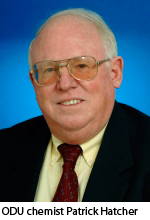
Patrick Hatcher, the Batten Endowed Chair of Physical Sciences at Old Dominion University, will share in a $7.2 million grant from the Gulf of Mexico Research Initiative (GoMRI) for environmental studies funded by the petroleum company BP in response to the Macondo oil well blowout in 2010.
He is part of a research team led by Texas A&M University marine biologist Antonietta Quigg that will conduct a three-year study titled "Role of Microbial Exopolymers in Aggregation and Degradation of Oil and Dispersants."
On Nov. 14, GoMRI announced grants totaling $140 million to 12 research consortia. The projects will begin early next year.
Hatcher oversees the ODU College of Science Major Instrument Cluster (COSMIC) facility, which has advanced technology chemical analysis instruments, and he said COSMIC played a key role in him being invited to join the consortium.
He added, "My research interests in the production of algal biopolymers is an important aspect of the project proposal and activities. The research will involve both field and lab mesocosm/microcosm studies of molecular-level changes in the oil components as the spilled oil reacts with algal and microbial exopolymers. The advanced instrumentation at ODU's COSMIC is specifically suited to provide the detailed chemistry needed for this."
As executive director of the Virginia Coastal Energy Research Consortium, Hatcher has led numerous studies of the alternative fuel potential of algae. These include his successful production of a substance similar to crude oil from a biopolymer in the algal cell wall.
Biopolymers are chains of molecules formed by organisms, such as amino acids that link up to form proteins. Exopolymers are biopolymers that are secreted by an organism into the environment, and in aquatic environments these secretions can form biofilms that protect bacteria colonies from environmental threats. The research Hatcher will be engaged in will test the possibility that exopolymers in the water can help with oil spill cleanups.
Together, the 12 research consortia that received GoMRI grants will conduct scientific studies of the impacts of oil, dispersed oil and dispersant on the Gulf of Mexico ecosystem and public health. These research investments focus on improving fundamental understanding of the implications of events such as the Macondo well blowout, and on developing improved spill mitigation, oil and gas detection, characterization and remediation technologies.
The consortia were chosen following a competitive, merit review process that evaluated research applications submitted to GoMRI in response to its RFP-IV program solicitation.
For the past several years, GoMRI has reached out to the public health research community. "It was clear that research on public health is needed," said Rita Colwell, chairman of the GoMRI Research Board. "I'm pleased that in this round of awards there are funds to study public health issues in the Gulf of Mexico region associated with the oil spill. We are also funding research focused on increasing our knowledge of the biology of the Gulf and the interaction of oil with the ecosystem."
This is the second round of funding provided by GoMRI to consortia - research groups consisting of a lead investigator and collaborators from four or more other institutions.
"A significant benefit of our prior support is increased collaboration among scientists and institutions across the Gulf. This round of funding will continue to build a research community focused on understanding the dynamics of the Gulf of Mexico ecosystem," said Colwell.
Forty-seven research proposals were received. Each proposal described how the consortium would operate and the kind of research it would conduct to increase scientific understanding of one or more of five research themes, which are:
- Physical distribution, dispersion, and dilution of petroleum (oil and gas), its constituents, and associated contaminants (e.g., dispersants) under the action of physical oceanographic processes, air-sea interactions, and tropical storms.
- Chemical evolution and biological degradation of petroleum/dispersant systems and subsequent interaction with coastal, open-ocean, and deep-water ecosystems.
- Environmental effects of the petroleum/dispersant system on the sea floor, water column, coastal waters, beach sediments, wetlands, marshes, and organisms; and the science of ecosystem recovery.
- Technology developments for improved response, mitigation, detection, characterization, and remediation associated with oil spills and gas releases.
- Impact of oil spills on public health, including behavioral, socioeconomic, environmental risk assessment, community capacity and other population health considerations and issues.
Research consortia selected for funding in addition to the one with which Hatcher will work are: Nova Southeastern University, "Deep-Pelagic Nekton Dynamics of the Gulf of Mexico;" University of Miami - Rosenstiel School of Marine and Atmospheric Science, "Relationship of Effects of Cardiac Outcomes in Fish for Validation of Ecological Risk;" University of Texas at Austin, "Dispersion Research on Oil: Physics and Plankton Studies;" University of Southern Mississippi, "Consortium for Oil Spill Exposure Pathways in Coastal River-Dominated Ecosystems;" University of Louisiana at Lafayette, "Littoral Acoustic Demonstration Center;" Marine Environmental Sciences Consortium/Dauphin Island Sea Lab, "Alabama Center for Ecological Resilience;" Louisiana Universities Marine Consortium, "Coastal Waters Consortium;" University of Miami, "The Consortium for Advanced Research on Transport of Hydrocarbon in the Environment II;" RAND Corporation Gulf States Policy Institute, "Consortium for Resilient Gulf Communities;" University of Georgia, "Ecosystem Impacts of Oil and Gas Inputs to the Gulf - 2;" University of South Florida, "The Center for the Integrated Modeling and Analysis of Gulf Ecosystems II."
GoMRI is a 10-year research initiative established in 2010 and funded by a $500 million commitment by BP. GoMRI is administered by an independent Research Board, which consists of 20 experts in science, research administration, and public health. The Research Board evaluates research proposals following merit review guidelines of the National Academies of Science and procedures similar to those of the U.S. National Science Foundation. All funding decisions are made by the Research Board, which is independent of BP and not connected to the Natural Resources Damage Assessment process.
https://www.tamug.edu/News/2014articles/QuiggAwardedMoney.html
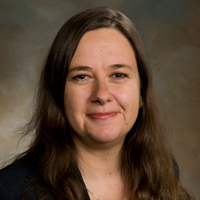
A research consortium led by Dr. Antonietta Quigg, Professor of Marine Biology and Associate Vice President for Research and Graduate Studies at Texas A&M’s Galveston campus, was awarded $7.25 million by the Gulf of Mexico Research Initiative (GoMRI) http://gulfresearchinitiative.org/ to conduct scientific studies of the impacts of oil on the Gulf of Mexico ecosystem and public health. This research will study the effects of the April 2010 Macondo well blowout, also known as the Deepwater Horizon oil spill and will focus on improving our fundamental understanding of the implications of such events and on developing improved spill mitigation, oil and gas detection, characterization and remediation technologies. It is part of a $140 million grant funded by British Petroleum to 12 research consortia to support research to be carried out from 2015 through 2017.
“It was clear that research on public health is needed,” said Dr. Rita Colwell, Chairman of the GoMRI Research Board. “I’m pleased that in this round of awards there are funds to study public health issues in the Gulf of Mexico region associated with the oil spill. We are also funding research focused on increasing our knowledge of the biology of the Gulf and the interaction of oil with the ecosystem.”
John Sharp, Chancellor of The Texas A&M University System, said a grant of this magnitude showcases the excellence of the research program at Texas A&M University at Galveston. “We’re honored to receive this grant and to have the opportunity for our Galveston campus to be part of this important group of studies,” Sharp said. “We have made a significant commitment to research initiatives across the Texas A&M System and a grant such as this helps confirm the importance of that commitment.”
Dr. Antonietta Quigg’s project entitled “Role of microbial exopolymers in aggregation and degradation of oil and dispersants”, will focus on developing a better understanding the molecular-level chemistry of sparingly-soluble substances in complex systems and the associated microbial communities.
Dr. Quigg’s consortium comprises 5 other collaborating institutions and Texas Sea Grant. Texas A&M University, including researchers from Marine Biology (Quigg), Marine Science (Dr. P. Santschi) and the Geochemical and Environmental Research Group (Tony Knapp and Dr. Terry Wade), will be responsible for the overall project management and lead the laboratory experiments and field collections. Collaborating institutions include the University of California - Merced, the University of Southern California, Mount Allison University (Canada), the University of California Santa Barbara, and Old Dominion University. Texas Sea Grant’s Josh Gunn will provide support for outreach activities through its well-established statewide and national networks.
“This is extremely important for those of us whose life, work and recreation are connected to the Gulf of Mexico” said RADM Robert Smith, chief executive officer at Texas A&M University at Galveston. “This also demonstrates the high level of research Texas A&M Galveston’s scientists achieve in understanding the dynamics of the Gulf of Mexico ecosystem.”
Texas A&M University at Galveston is the maritime and marine campus of Texas A&M University at College Station. It is a special purpose institution offering academic programs, research and service in marine and maritime studies. The institution is home to the Texas A&M Maritime Academy the only maritime academy located on the Gulf Coast. Texas A&M Galveston’s Aggies like their College Station counter-parts, receive the Aggie Ring and a Texas A&M University diploma.